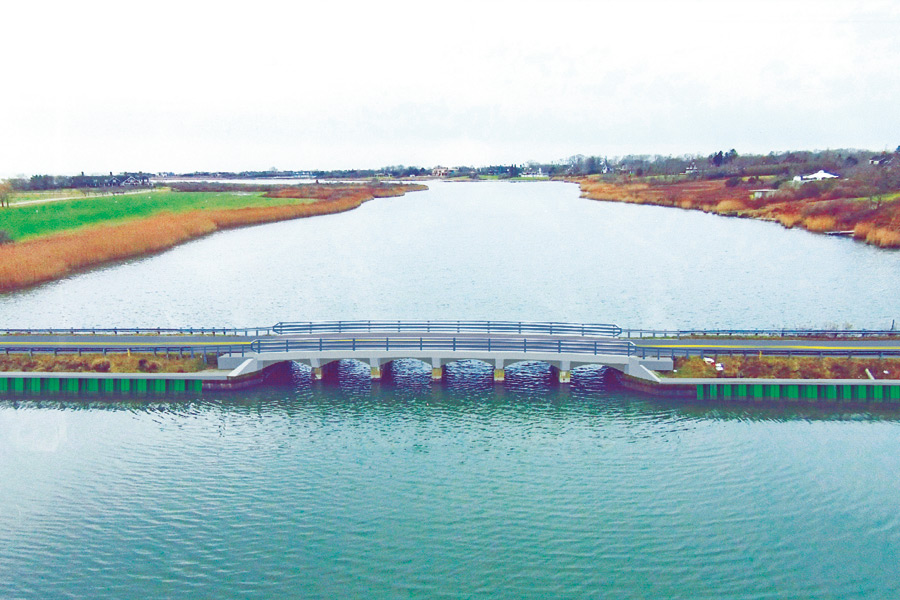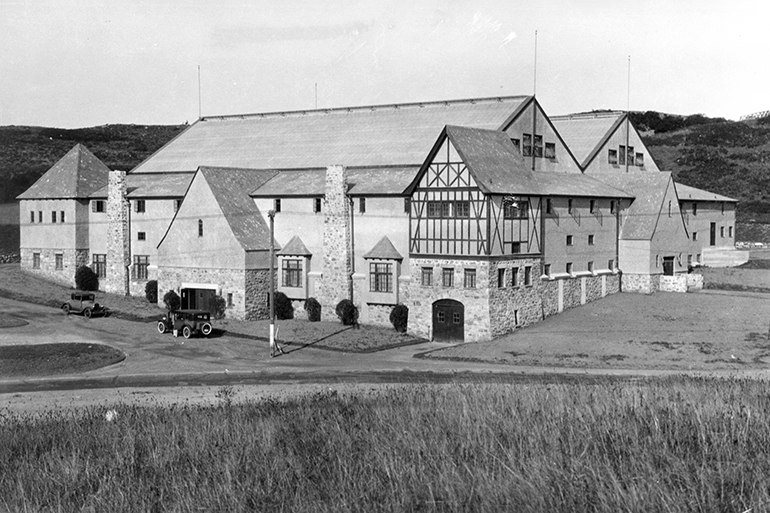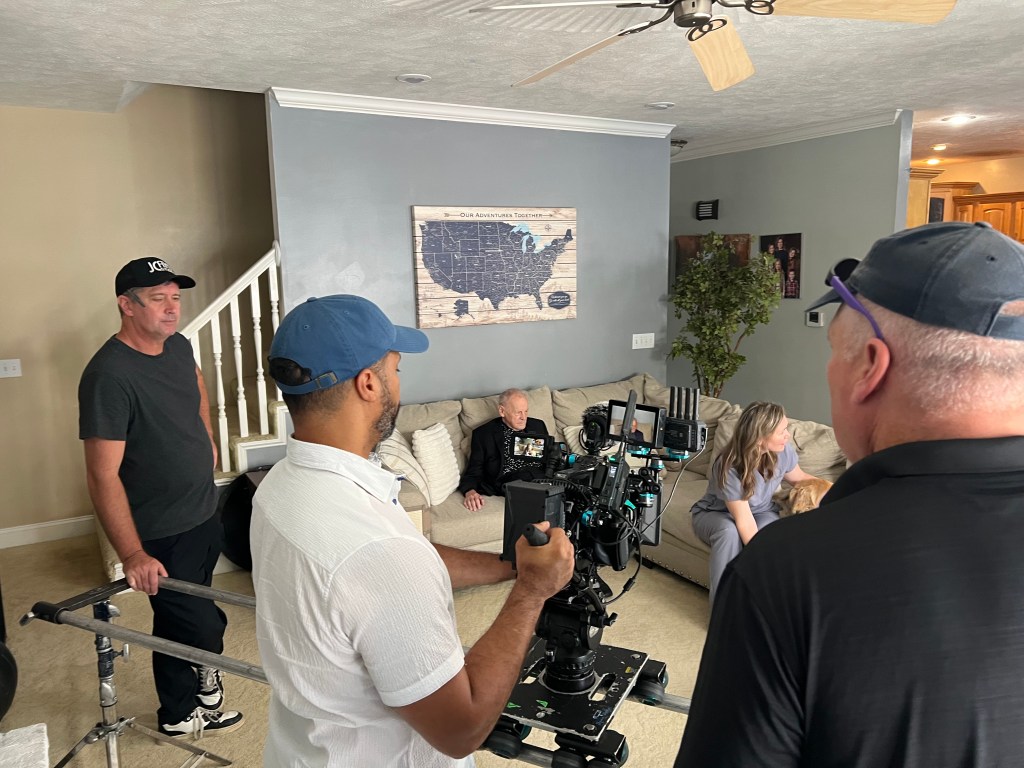Protestors Arise! We Saved the Sagg Bridge Once, Now Let's Do It Again

The Sagg Bridge was originally built in 1686 by Ezekiel Sandford to make it easier for horse drawn vehicles to get from Mecox to Sagaponack. Without the bridge, one had to go about half a mile further north to roads that went around Sagg Pond. With the bridge, it was faster.
In time it became so popular that the small village of Bullhead, which had been set up further to the north in the middle of the South Fork, got identified as the place nearest to the bridge, and that village soon bore the name Bridgehampton.
This bridge has been rebuilt and changed over the years, but it has always been a modest structure, barely wide enough for two cars to pass each other. It’s always had a footpath on one side—now a sidewalk—where fishermen can sit by a railing and throw hooks into the water to catch their fish for a nice fresh dinner. Its entire length—it leaps up from the shore on one side of Sagg Pond to hump over the water and come down on the other—is no more than 100 yards. You drive slowly across it because of the hump and the fishermen and also, I think, because it is so picturesque. I cannot recall a single accident on it. And it remains today in the concrete-and-steel configuration that replaced the wooden bridge in 1923, a century ago. After that it could easily handle cars, small trucks and farm tractors up to a capacity of 4 tons.
It’s fair to say that the Sagg Bridge, as it has come to be known, is probably the only historic bridge on the South Fork. It is to the Hamptons what covered bridges are to New England: historic, beautiful, unique and, at least from the bureaucratic point of view—completely substandard. The Town of Southampton has proposed to bring this bridge up to current motoring standards—make the lanes wider, add additional steel railings to keep people from falling off (into the water ten feet below) strengthen it underneath, raise the level of it where it leaps up from the shoreline so there is less of a hump—so you wind up with a bridge that is safer, stronger and no longer necessary to slow down for. Of course, the sidewalks will have to go. Nobody should be walking across this bridge, anyway, unless they want to get killed. Fishing? Forget it.
Needless to say, there are a few of us, this writer among them, who want to keep the beautiful historic old bridge in exactly the same configuration as it is now. Strengthen it from underneath, by all means. But leave how it looks alone.
As a matter of fact, we already saved it. It was in the early 1980s, a whole generation ago. The proposal at the time came from the county, which would use federal funds to re-do the bridge wider, stronger and uglier. It would also need to meet federal bridge standards, which at the time meant the strength to carry 40-ton vehicles, such as military tanks. Should America be invaded, Sagaponack, Mecox and Bridgehampton would not stand in the way of a brisk defense.
Needless to say, back then there were demonstrations and protests in the community to save this bridge. People carried signs and walked back and forth across the bridge. The late painter Robert Dash made an oil painting of the old bridge whose sale benefited the Save the Bridge committee. I still have a program from a concert held at the Beebe Windmill on Ocean Road in Bridgehampton one Saturday afternoon, whose proceeds also went to the Save the Bridge committee.
Why should I have saved this program? Well, as it happened, I had a band at the time that performed at this concert. It was the only band I ever had and the only concert my band played in. A crowd of 500 people stood on that lawn and as Dan’s Rocky Mountain Boys played “You Are My Sunshine,” “The Wabash Cannonball” and “The Battle of New Orleans,” everybody sang along and cheered or, annoyingly, just continued to talk to one another, chattering away as we played. It was one of the highlights of my life. I played autoharp and harmonica and sang.
I also have a clipping from The New York Times dated February 7, 1988, the year following the concert, which proclaims that after this five-year battle swayed back and forth, we won. A new county supervisor was elected, Patrick Halpin. He addressed himself to this problem. “I am a preservationist,” he said. “We will repair the Sagg Bridge with county money. There will be no federal money.” The county had reversed itself.
And so we saved the bridge. Had they built new one, it would have cost a ton of money and would have lasted 50 years (so said The Times). Instead, only half a ton of money was spent, and with the repairs it would need more work in 15 to 25 years.
So here it is, 25 years later. Well, 29 years later. We got an extra four years out of it. And now the bureaucrats are faced with what to do with the Sagg Bridge again. And once again, they propose to turn it into ugly and awful, but safe—safe for motorists, anyway. Again the sidewalk goes, again the fishermen go. Again the railing gets raised, again the hump gets lowered by raising the approaches. It will be up to snuff for tanks.
DON’T YOU GUYS REMEMBER? WE SAVED THE BRIDGE.
Turns out somebody forgot to fill out a form. During the 1990s, there was a paper being handed around which went out to the towns and villages in which it was asked what was historic and should be saved. The windmills got on it, the lighthouse got on it. They forgot the Sagg Bridge.
Before I explain the more complicated story involving the current battle, I would like to point out that the bureaucrats currently are pulling the same trick as the bureaucrats did in the 1980s. To get people to agree the bridge had to be brought up to snuff, they declared it so rickety as to be about to fall down, so it got closed to vehicular traffic. Back then, they shut it for TWO YEARS.
At that time, we were running the 10K Dan’s Papers PotatoHampton Minithon, which, at a certain point, had entrants running across the bridge. There may have still been pedestrians walking across that closed bridge and there may have been fishermen—they didn’t weigh very much, so there was no danger to the bridge—but it was then ruled that our race, which had about 700 runners, would be putting too much of a strain on the bridge. What was going on? I inquired. The fear was that the runners would cross it in lockstep, as when a band marches along. I pointed out that the start of the race was two miles back and by the time they got to the bridge, all the runners were way spread out down the road. There would be no lockstep. These were pedestrians, just like any others.
The bureaucrats relented. But they insisted on a requirement: It was necessary that we post an official at the foot of the bridge to shout to runners to be careful not to cross in lockstep. Our official could also stop the race by waving his arms if the bridge collapsed or started shaking badly. We complied. At the time, our race benefitted Stony Brook University Hospital. They volunteered a resident in the Psychiatry Department. We had a young psychiatrist at the entrance to the bridge watching out for lockstep (see photo below).

Well, here is where things stand today. Today the bridge is no longer being maintained by the county. It is being overseen instead by the Town of Southampton, in which it resided until 2005. In that year, the bridge was no longer fully in Southampton. This is so weird. In that year, the unincorporated hamlet of Sagaponack decided to become incorporated. It did so. It is incorporated today, with a village hall and a mayor and so forth. And the border of the new village runs right down the center of Sagg Pond, which means it runs across the center of the Sagg Bridge. You come down to the bridge on the Mecox side (Mecox is a hamlet in the Town of Southampton) and you go up the hump and across the bridge, but when you arrive 100 yards later down on the other side of the bridge, you are in the Village of Sagaponack.
This did not change who is in charge of the bridge, however. That remains Southampton. And the head of the highway department of Southampton, Alex Gregor, seeing that the bridge was once again getting shaky and seeing that federal funds were again available, has re-invented the wheel, creating virtually the same plan—to repair the bridge by lowering the hump, widening the lanes, doing away with the fishermen and raising the railing so god forbid nobody should fall over into the water ten feet below and sue the town—that was presented 30 years ago.
He’s pretty adamant about it. He wants the bridge safe for motorists. He wants to bring it up into the 21st century. And he is proceeding apace to get it all approved. Once again, the feds pay. But this approval process has slowed because the Village of Sagaponack and most of the people in Bridgehampton and Mecox apparently object to wiping out the beautiful old lines of this historic bridge.
The Mayor of Sagaponack is Don Louchheim. He is, on behalf of his constituents, adamant that the bridge be saved. He is old enough to remember the battle a generation ago, and he was here at that time. And he has the wherewithal. Very wealthy people live in the Village of Sagaponack. Zip code comparisons rate Sagaponack as one of the richest communities in America. So it is King Kong versus Godzilla. And somebody has to give way.
Sagaponack presented a plan to take over the care of the bridge from Southampton. It would cost Southampton nothing. Southampton could use the federal money for something else. Southampton rejected it. Sagaponack offered to buy the bridge outright. Southampton rejected that. Sagaponack now says it will have lawyers attempt to get the rest of the bridge by eminent domain, forcing Southampton to sell it. They will do this using the same laws municipalities use to confiscate private property.
I think it is time to bring Dan’s Rocky Mountain Boys back for another concert appearance at the Beebe Windmill.









